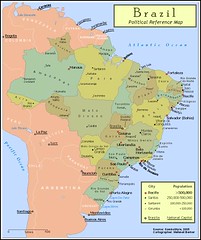The Federative Republic of Brazil (Portuguese: República Federativa do Brasil), is the largest and most populous country in South America.[5] It is the fifth largest country by geographical area, the fifth most populous country, and the fourth most populous democracy in the world, according to Wikipedia.
The Brazilian population is predominantly Roman Catholic, almost all Portuguese-speaking and multiethnic.[6] Brazil is also home to a diversity of wildlife, natural environments, and extensive natural resources in a variety of protected habitats.
Unlike Christopher Columbus, who thought he had reached India, the Portuguese Vasco da Gama had already reached India sailing around Africa two years before he reached Brazil.
Nevertheless, the word índios ("Indians") was by then established to designate the peoples of the New World and stuck being used today in the Portuguese language, while the people of India are called indianos.
Initially, the Europeans saw the natives as noble savages, and miscegenation (cohabitation and creolization) of the population began right away. Tribal warfare and cannibalism convinced the Portuguese that they should "civilize" the Amerindians.[12]
The climate of Brazil comprises a wide range of weather conditions across a large geographic scale and varied topography, but the largest part of the country is tropical.[5] Analysed according to the Köppen system, Brazil hosts five major climatic subtypes: equatorial, tropical, semiarid, highland tropical, and temperate; ranging from equatorial rainforests in the north and semiarid deserts in the northeast, to temperate coniferous forests in the south and tropical savannas in central Brazil.
Brazil's large territory comprises different ecosystems, such as the Amazon Rainforest, recognized as having the greatest biological diversity in the world;[76] the Atlantic Forest and the Cerrado, which together sustain some of the world's greatest biodiversity.
Scientists estimate that the total number of plant and animal species in Brazil could approach four million.[77] Larger mammals include pumas, jaguars, ocelots, rare bush dogs, and foxes. Peccaries, tapirs, anteaters, sloths, opossums, and armadillos are abundant. Deer are plentiful in the south, and monkeys of many species abound in the northern rain forests.
Its natural heritage is extremely threatened by to cattle ranching and agriculture, logging, mining, resettlement, oil and gas extraction, over-fishing, expansion of urban centres, wildlife trade, fire, climate change, dams and infrastructure, water contamination, and invasive species.[76] In many areas of the country, the natural environment is threatened by development.
Brazil is the largest national economy in Latin America, the world's tenth largest economy at market exchange rates[83][84] and the ninth largest in purchasing power parity (PPP),[85][86] according to the International Monetary Fund and the World Bank; with large and developed agricultural, mining, manufacturing and service sectors, as well as a large labor pool.
Brazil's booming economy is shifting into overdrive, with biofuels and deep-water oil providing energy independence and the government collecting enough cash to irrigate the desert and pave highways across the Amazon Rainforest.
Most Brazilians can trace their ancestry to the country's indigenous Amerindians, Portuguese colonists, or African slaves, either alone, in combination with one or both of the others, and/or in combination with other ethnic or racial groups.
Brazil is the only Portuguese-speaking nation in the Americas, making the language an important part of Brazilian national identity and giving it a national culture distinct from its Spanish-speaking neighbors.
Brazil's cultural tradition extends to its music styles which include samba, bossa nova, forró, frevo, pagode, and many others.[146] Brazil has also contributed to classical music, which can be seen in the works of many composers.
The festival of Carnival (Portuguese: Carnaval), with its spectacular street parades and vibrant music, has become one of the most potent images of Brazil;[145] an annual celebration held forty days before Easter and marks the beginning of Lent.
Football is the most popular sport in Brazil.[145] The Brazilian national football team (Seleção) have been victorious in the FIFA World Cup tournament a record five times, in 1958, 1962, 1970, 1994 and 2002.[153]
Basketball, volleyball, auto racing, and martial arts also attract large audiences. Some sport variations have their origins in Brazil. Beach football,[154] futsal (official version of indoor football)[155] and footvolley emerged in the country as variations of football. In martial arts, Brazilians have developed Capoeira,[156] Vale tudo,[157] and Brazilian Jiu-Jitsu.[158] In auto racing, Brazilian drivers have won the Formula 1 world championship eight times.
Wednesday, October 22, 2008
Subscribe to:
Post Comments (Atom)


No comments:
Post a Comment